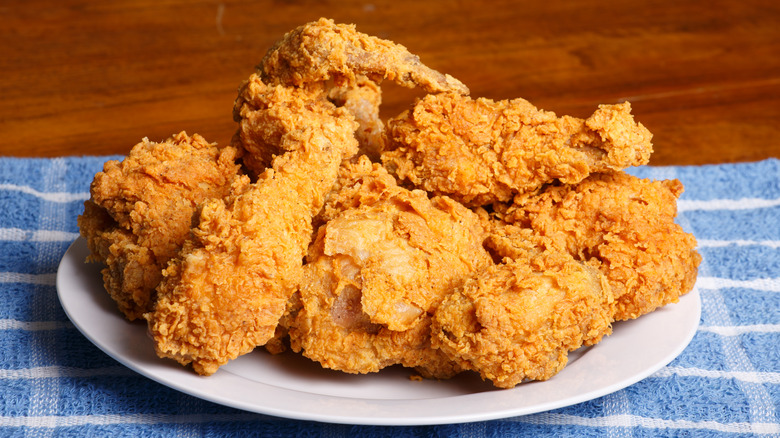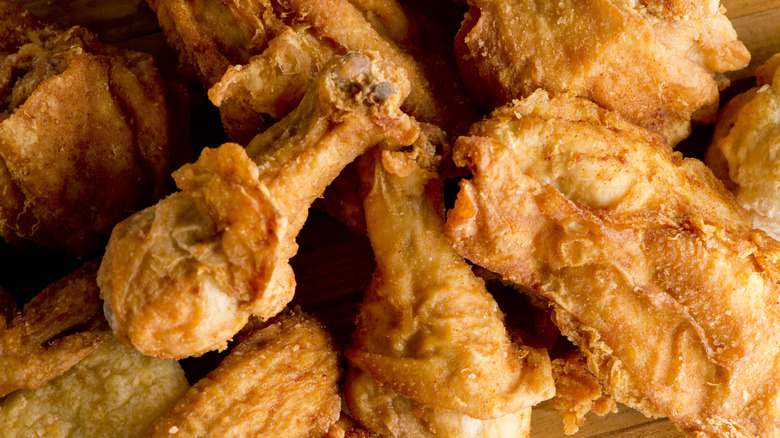You Should Rest Fried Chicken Before Eating It. Here's Why
There's something really special about biting into a hot piece of freshly-made, perfectly-seasoned fried chicken. With crispy, crunchy skin on the outside and tender, juicy meat on the inside, it's the ultimate comfort food that's equally at home with paper napkins and a picnic blanket as it is with fine flatware and white tablecloths.
American-style, southern fried chicken has been around for more than a century, per the BBC, and thanks to Nashville hot chicken, Korean "candy chicken" styles, and many more, the dish continues to dominate the food scene. The fastest growing fast food restaurants in the United States are chicken concepts, and chicken actually eclipsed burgers as the number one category of fast food in 2017, according to Business Insider. It's also popping up everywhere on fast casual and even some fine dining menus. Even though there are more choices than ever for ordering fried chicken, you can make the classic crispy bits in your own kitchen as long as you have a good recipe and a little know-how.
While it's true that homemade fried chicken isn't the easiest recipe to pull off, it's far from impossible. The most important ingredient for making the best breasts and thighs, besides the actual chicken and spices, is a little patience.
Don't forget to rest your chicken
Google "fried chicken recipe" and you're bound to get overwhelmed by the sheer volume of variations, plus plenty of lists of dos and don'ts. If it's your first time making homemade fried chicken, do your recipe research and take some time to familiarize yourself with the mechanical steps of the process. The perfect fried chicken is all in the details, from the size of the pieces to the process of brining and breading, down to the cooking itself.
One of the steps that a lot of home cooks forget or skip is resting the pieces of fried chicken after they're cooked. The famous British celebrity cook Keith Floyd once said, "Cooking is an art and patience a virtue," and even though it seems like chefs are all about the speed and hustle of the kitchen, all good cooks know the difference between when it's time to hurry and when it's time to wait.
After your chicken is cooked and looking golden brown, it's very tempting to dig in and start feasting. If you do, however, Southern Living reports that your chicken hasn't had a chance to rest and redistribute the juices inside, and the chicken won't seem as moist and tender. Plus the crust is scalding hot, and you'll probably burn the inside of your mouth. Take a beat and give your chicken about ten minutes to rest on a wire rack or over some paper towels to drain before you serve it.
The science of resting
When you're cooking meat, the proteins squeeze together and push out moisture when they're heated, which is what we recognize as "juices." According to Cook's Illustrated, you can prevent a loss of up to 60% of the juices in a cooked piece of meat by just waiting 10 minutes before you slice or serve it. That little bit of rest allows the cooked proteins to contract as they cool, which will redistribute the moisture. This moisture loss improves even more the longer you let the chicken (or other piece of meat) rest, but 10 minutes is an optimal time so that your food is still warm for serving, but not too hot to enjoy. The wire rack is also crucial, as Bon Appetit says that cooling your chicken directly on paper towels will allow it to steam and make the crispy skin turn soggy.
There's also a bonus rest in the fried chicken process to consider as well, which is not quite as crucial as the first, but if you have the time you should certainly try. If the breading on your chicken pieces seems to come out uneven and blotchy, Cook's Country suggests letting it rest on a wire rack for about 10 minutes to help the coating stick before you start frying.
Give your chicken a little space to do its thing by resting, and if you're following the recipe, and using the right pan, you should have no problem frying up a fabulous southern-style feast.


